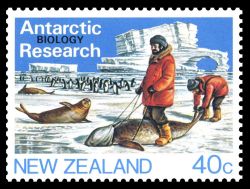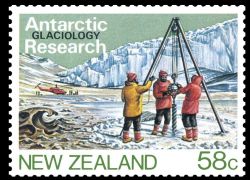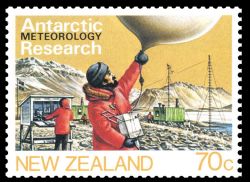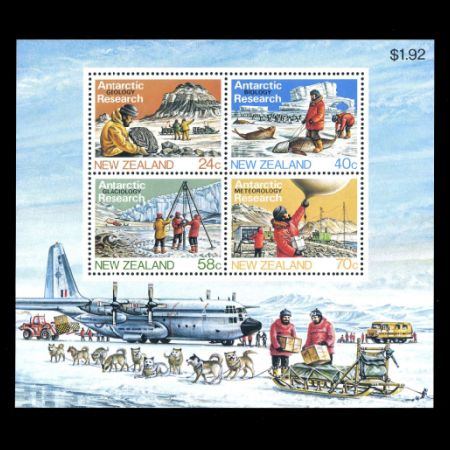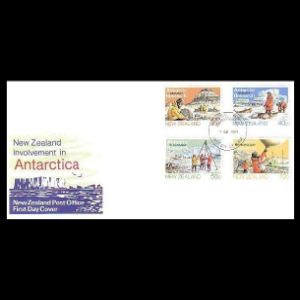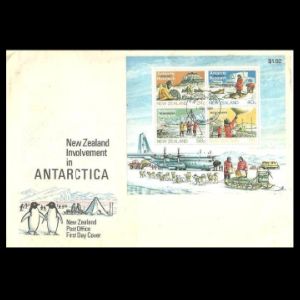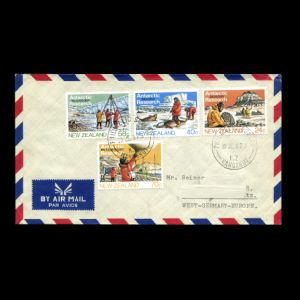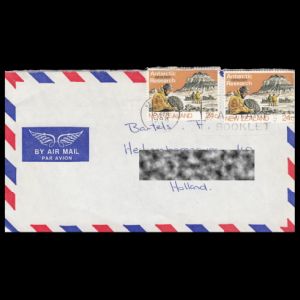New Zealand 1984 "New Zealand involvement in Antarctica"
| << previous page | back to index | next page >> |
| Issue Date | 01.02.1984 |
| ID | Michel: 889-892, BL. 5; Scott: 791-794 ; Stanley Gibbons: 1327-1331; Yvert et Tellier: 859-862, BL. 49; Category: pF |
| Design | Maurice Conly |
| Stamps in set | 4 |
| Value |
24c - Geological Research 40c - Biological Research 58c - Glaciological Research 70c - Meteorological Research |
| Emission/Type | commemorative |
| Issue place | Wellington |
| Size (width x height) |
stamps: 42 mm x 30 mm Mini-Sheet: 126 mm x 110 mm |
| Layout | 100 stamps in sheet |
| Products | FDC x 2, MS x 1, PP x2 |
| Paper | unwatermarked |
| Perforation | 13.75 x 13.50 |
| Print Technique | Lithography |
| Printed by | Cambec Press, Melbourne, Australia |
| Quantity | Stamps: 15.550.000,
5.500.000,
5.440.000,
5.450.000. Mini-Sheet: 690.000 |
| Issuing Authority | New Zealand Post |
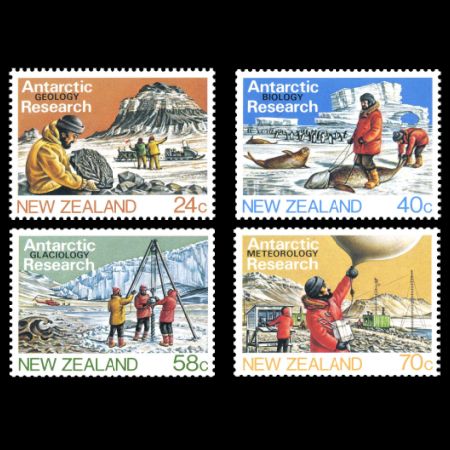
On February 1st, 1984, the Post Authority of New Zealand, on occasion of the 50th jubilee of the New Zealand Antarctic Society, issued the set of 4 stamps "New Zealand involvement in Antarctica".
The following text is based on the press release of the New Zealand's Post, published on their website and Philatelic Bulletin No. 30 from October 1983. The text about the discovery of the plant fossils in Antarctica was added by author of this website.
These stamps were designed by Maurice Conly of Waikanae, the official artist for the Antarctic Division of the Department of Scientific and Industrial Research and were issued in individual sheets of 100 and a Mini-Sheet of all 4.
The Mini-Sheet shows a RNZAF Hercules transport aircraft on the Williams Field which is the "airport" for everyone arriving on the ice. Also featured are the Scott Base huskies, the original form of transportation in the Antarctic, and now quite a tourist attraction according to Mr. Conly who has visited the area several times.
In the last 100 years, 'Terra Australis Incognita', the 'Hidden Southern Land', has been slowly unveiling its secrets after spending a lifetime in forbidding silence. Its 14 million square kilometres of ice and snow is described as being the driest, coldest and windiest place in the world. Yet, undeniably, this cruel continent commands an air of awesome significance and supreme beauty.
On the southern most tip of Ross Island, located on the edge of the Ross Ice Shelf on the Antarctic continent, is Scott Base, established in 1957 to support New Zealand's participation in the International Geophysical Year scientific research programme. Since then, it has been continuously occupied by scientists and support staff.
Today, up to 300 New Zealanders are involved in Antarctica during the summer season, conducting scientific studies at Scott Base and in more remote areas of the Dependency, and providing vital support facilities. During winter up to 12 staff members stay at Scott Base to sustain important continuous scientific observations.
Today, most of New Zealand's Antarctic involvement is in the Ross
Dependency, named after James Clark Ross, who led a British expedition from 1839-43 which
penetrated the Ross Sea and discovered the Ross Ice Shelf, McMurdo Sound and Ross Island.
The two main peaks of Ross Island are named after his ships "Erebus" and "Terror".
Britain claimed the Ross Sea area in 1887, and in 1923 placed the region under the jurisdiction
of the Governor-General of New Zealand.
Due to its geographical position, New Zealand has been used as a staging point from many Antarctic expeditions and this has forged close links with the southernmost continent. New Zealand's involvement in Antarctica is the topic of special stamp issue featuring 4 stamps depicting areas in which some of the most important studies are currently being made - geology, biology, glaciology and meteorology.
Geological Research - at Shapeless Mountain:
New Zealand geologists have for many years conducted study programmes of the Beacon Supergroup rock formations of Shapeless Mountain and Mt Fleming at the head of the Wright Valley in the Dry Valley's region of Antarctica.
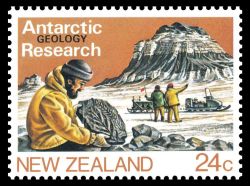 |
| Plant Fossil on Geological Research stamp of New Zealand 1984 MiNr.: 889, Scott: 791. |
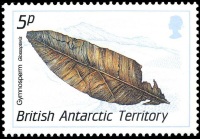 |
| Glossopteris on definitive "Fossils" stamp of British Antarctic Territory 1990, MiNr.: 161, Scott: 158 |
Studies carried by New Zealanders in the Ross Dependency have led to a great variety of fossil discoveries. These remnants are evidence of the likely measure of mineral deposits they can expect to find in this land.
The first plant fossil discovered in Antarctica was discovered by Robert Falcon Scott in 1912, during his second, fatal, expedition.
Robert Falcon Scott
CVO (6 June 1868 – 29 March 1912) was British Royal Navy officer and explorer
who led two expeditions to the Antarctic regions:
the Discovery expedition of 1901–1904 and
the ill-fated Terra Nova expedition of 1910–1912.
On the first expedition, he set a new southern record by marching to latitude 82°S and discovered the
Antarctic Plateau, on which the South Pole is located.
On the second venture, Scott led a party of five which reached the South Pole on 17 January 1912.
Scott and his companions died on the second expedition.
These fossils promised to Marie Stopes were to provide evidence for Eduard Suess’s hypothesis that Antarctica had once been part of an ancient supercontinent named Gondwanaland (or also referred to as Gondwana).
The plant fossils Scott’s party found on that day in 1912 led to a breakthrough in the geological understanding of Antarctica. It would feed into the burgeoning debate at that time on Gondwanaland, Continental Drift and Antarctica’s role in the formation of the continents. At the end it proved that Antarctica had once been warm and connected to other continents as suggested by Eduard Suess, as the same fossils are found in Australia, Africa and South America, it was like finding a missing piece of the Earth's jigsaw. It indicated that these countries had all been part of the same prehistoric land mass.
Products and associated philatelic items

|
References
-
Technical details and short description of the stamps:
Acknowledgements
Many thanks to Dr. Peter Voice from Department of Geological and Environmental Sciences, Western Michigan University, for reviewing the draft page and his valuable comments.| << previous page | back to index | next page >> |
